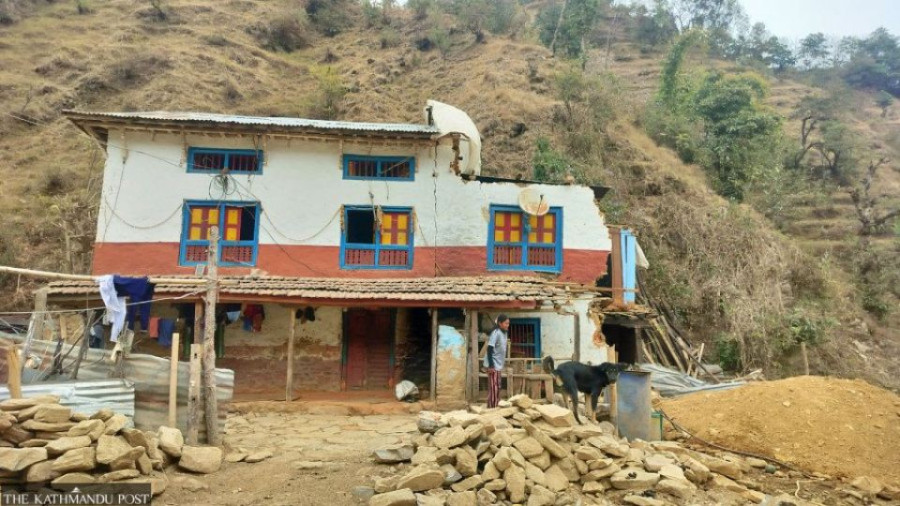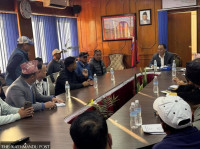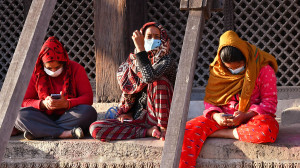Bagmati Province
Displaced and forgotten, Roshi families dread looming monsoon disaster
Still without help after October floods, survivors live amid crumbling hills, swelling river.
Jyoti Shrestha
In Mahari of Panauti Municipality, Bishnu Bahadur Mulmi’s home sits dangerously close to the edge of the Roshi river. Behind his house, the scars from last year’s landslide remain untouched. Since a devastating flood and landslide struck in October last year, his family has been living in constant fear.
“Every time the clouds gather, I worry—what if it rains heavily again? Where would we go?” said Mulmi with anxiety etched across his face. “This is the only home we have left. Everything else is gone. We have neither money nor land to build another.”
Eight months after the disaster, the government has finally provided Rs25,000 to the affected families as the first installment for temporary housing. But for most, like Mulmi, it’s nowhere near enough. “Even finding a safe place to build a shelter is impossible,” he added.
Rajendra Shrestha, a resident of nearby Mahabhir along the Araniko Highway, lost his home, farmland, and shop to the floods. After briefly staying with relatives, he has been renting a room in Banepa for the past eight months. “It’s impossible to live under constant threat of both landslides and floods,” he said. “We’re paying Rs15,000 in monthly rent. The money from the government isn’t enough to move to a safer place, and the old place is trapped between landslides from above and floods from below.”
Shrestha blames local mining and crusher plants for worsening the problem. “They dump waste directly into the river, increasing the flood risk,” he claimed.
Dilkumari Raut, aged 61, recounted the terrifying night when the Roshi river flooded her courtyard. “We walked for hours in the dark just to reach Panauti Bazar and save our lives,” she said. “Since then, the fear has only grown. The mines dump dust and debris into the river, blocking its natural course. Just like last year, there's a real fear it will flood again.”
Raut also pointed out cracks on nearby hills left by the previous landslides. “If there’s heavy rain again, more landslides are inevitable.” Despite the obvious dangers, she expressed frustration at the government’s inaction: “They don’t show any concern.”
Displaced families complain they have been left in the lurch due to lackadaisical response of the government on reconstruction and rehabilitation.
Jamuna BK, 55, said she’s lost the courage to rebuild. After the 2015 earthquake, she built a new home in Roshi Bazaar, only for it to be swept away by last October’s flood. “Not just the house, even the land and food we had stored—everything was taken by the floods,” she said, as tears welled in her eyes. “Even if we had the money for temporary housing, how can we build again in such a dangerous place?"
Most flood and landslide survivors in Kavrepalanchok district share similar anxiety. “How can we live in such a high-risk area? Where do we build a safe shelter?” they ask.
Despite such harsh reality, authorities have shown little urgency. Mayor Ram Sharan Bhandari of Panauti Municipality acknowledged that Kalanti, Roshi Bazaar, Dam Site, Malpi, Thumki Danda, Nepane, Ladkeshwar, Nayagaun and Panauti Bazar are high-risk areas.
“Yes, these settlements need to be relocated,” he said, “but the municipality alone cannot make such decisions. We need geological surveys by experts. We’ve informed both provincial and federal governments, but not much has been done.”
Dinesh Lama, chairman of Roshi Rural Municipality, said several wards, including Narayantaar in ward 2, Deurali in ward 9, and Kaladhungaa in ward 11, are highly vulnerable. “We’ve already decided in the executive committee to relocate the Deurali settlement and forwarded the plan to the federal government,” he said. “But there’s been no response or decision from the centre.”
The situation is just as dire in Bethanchok Rural Municipality. Bhagawan Adhikari, the rural municipality’s chief, said that 120 settlements of various wards in the local unit are at high risk.
“We’ve collected and submitted data, but local governments alone don’t have the authority to relocate entire communities. The federal government has to take the lead, and so far, it hasn’t.” He added that they have warned local residents and kept disaster response tools on standby as the monsoon approaches.
A District Disaster Management Committee meeting held in October last year had decided to request a geographical risk assessment from the National Disaster Risk Reduction and Management Authority and the Urban Development and Building Construction Office. The meeting also instructed all local disaster committees to identify uninhabitable settlements and submit reports.
But nearly seven months later, there has been no action. Chief District Officer and committee coordinator Umesh Kumar Dhakal confirmed the delay: “We’ve repeatedly reminded the federal authorities, but no action has followed.”
“Local governments have already submitted details of the high-risk settlements,” he added. “The central government hasn’t shown much interest despite the massive loss of life and property caused by the floods and landslides in October."
According to district records, 78 people died while six remain missing from disasters that hit various parts of Kavrepalanchok between October 11 and 12 last year. The government declared 13 local units, including Panauti, Roshi, Bethanchok, Temal, Panchkhal, Namobuddha, Mandandeupur, Bhumlu, Chaurideurali, Khanikhola and Mahabharat, crisis-hit zones.
Yet, for families like Mulmi’s and Jamuna BK’s, this designation offers little comfort as they brace for another monsoon, still living where they nearly died.




 9.12°C Kathmandu
9.12°C Kathmandu









%20(1).jpg&w=300&height=200)

